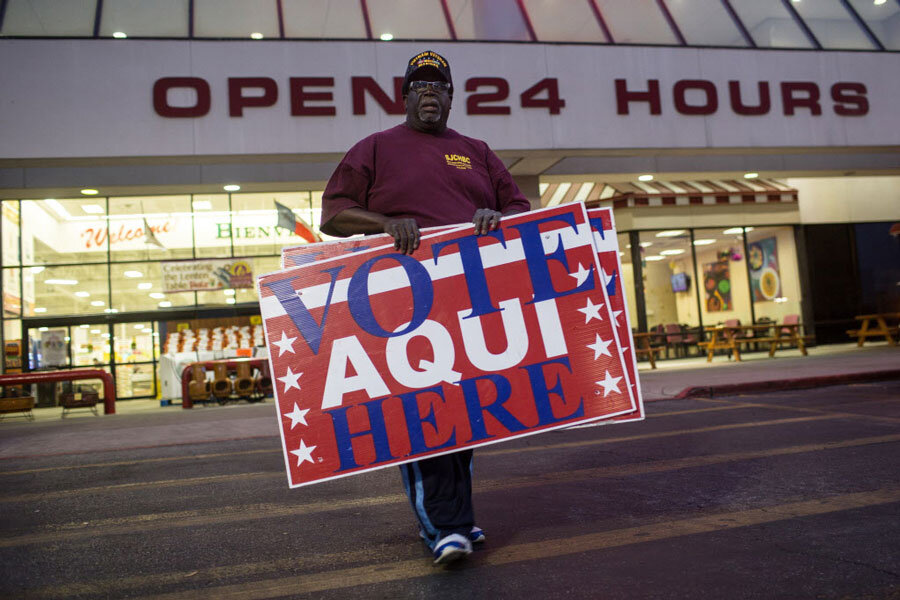Super Tuesday: What GOP’s record turnouts say about unique 2016 race
Loading...
| Washington
Republicans – particularly Donald Trump – are crowing about record turnouts in the first four nominating contests, while Democratic turnout has slumped compared with 2008, the party’s last competitive primary season.
Mr. Trump’s outsize presence in the race is clearly a factor. The Donald himself was quick to brag about the disparate turnout trends in a tweet Sunday morning, after Democratic frontrunner Hillary Clinton crushed Bernie Sanders in the first Southern primary.
“While Hillary and I both won South Carolina by big margins, Repubs got far more votes with a massive increase from past cycles. GROWING PARTY,” the billionaire showman wrote.
But don’t read too much into the GOP’s turnout numbers, even if they continue to break records in the 12 contests on March 1, aka Super Tuesday, analysts say. For starters, strong Republican turnout now doesn’t guarantee victory over the Democratic nominee in the general election.
“Just because Democrats are coming down from their 2008 highs, it doesn’t necessarily mean that come November their voters aren’t going to show up to vote,” says Michael McDonald, a political scientist at the University of Florida in Gainesville.
And don’t give Trump all the credit for the GOP’s record-breaking turnout numbers; another factor has been the size of the field.
“Turnout rates in presidential nomination contests are highly sensitive to the levels of competition,” says Professor McDonald, an expert on election turnout.
When the primaries began, the Republicans had 17 major candidates to the Democrats’ three. Even now, there are still five Republican candidates in the race (to the Democrats’ two), and the competition remains fierce as Trump threatens on Tuesday to move a big step closer to locking down the nomination.
In the early states, in particular, high levels of advertising, campaign organization, and voter outreach from so many candidates engaged Republicans like never before since the advent of the modern nomination system. On top of that, the Trump phenomenon has captured attention in a big way, both through his massive rallies and wall-to-wall TV coverage.
Some of the Trump-driven turnout is people motivated to vote against the controversial billionaire. How the anti-Trump Republican vote plays out in November, should he win the nomination, is a big question. Some conservative Republicans, including Nebraska Sen. Ben Sasse, have pledged not to vote for Trump and say they will find a “third option.”
“Trump is a polarizing figure, even within the GOP,” says McDonald. “There are some people showing up to vote for him, and some showing up to vote against him. It’s not clear how much this enthusiasm will translate into the general [election] if Trump is the nominee.”
Mrs. Clinton, the Democratic front-runner is polarizing, too, and many anti-Trump Republicans can be expected to hold their noses and vote for the billionaire as a vote against Clinton.
But for now, the early turnout numbers tell a story. In Iowa, Republicans drew 180,000 people to the caucuses, up from 121,000 in 2012. In New Hampshire, GOP primary turnout was 284,000, up from 248,000. In South Carolina, the party drew 730,000 voters to its primary, versus 603,000 in 2012. And in Nevada, 75,000 people turned out for the caucuses, up from 33,000 in 2012.
The Democrats, in fact, beat the Republicans on caucus turnout in Nevada this year with 80,000, but that figure was well below the 2008 Democratic turnout of 120,000. A month ago in Iowa, Democrats drew 171,000 to the caucuses, compared with 240,000 in 2008. In the Feb. 9 New Hampshire primary, Democratic turnout was 251,000, versus 289,000 in 2008. And in South Carolina last Saturday, 367,000 Democrats voted, a 30 percent decline from 2008.
In 2008, the Democrats fielded a large number of candidates – Barack Obama, Hillary Clinton, John Edwards, Joe Biden, and four others – but the race quickly winnowed down to then-Senator Obama and then-Senator Clinton. Interest was high from the start, and remained high, as both Obama and Clinton sought to make history.
But it’s not necessarily fair to compare the 2016 Democratic turnout numbers to those of 2008, or suggest that because the Republicans are beating Democrats in turnout in the early contests, that bodes ill for the Democratic nominee’s chances in November.
“Go back to the 2000 elections,” says McDonald. “The Republicans had much higher turnout rates in the early contests than the Democrats did, with much greater differentials than we’re seeing now. By November, the general election was one of the closest in modern history, and the Democrat won the popular vote.”
Amy Walter, national editor at the Cook Political Report, also warns against conflating the Republican “turnout surge” with electability in the general election.
“Every action has an equal and opposite reaction,” Ms. Walter writes. “Getting more white and angry voters to the polls with nativist language also helps to turn out passive Democratic voters who might have stayed home but for the threat of Trump’s candidacy.”
Democrats started the 2016 cycle laboring under a huge “enthusiasm gap.” In late December, a poll by CNN/ORC International found that 36 percent of Republicans and Republican-leaning independents were “extremely enthusiastic” about voting for president in 2016, while just 19 percent of Democrats and Democratic-leaning independents felt that way.
By the end of February, Democrats had closed that 17 point gap to 8 points. Now, 31 percent of Republicans and Republican leaners are “extremely enthusiastic, versus 23 percent of Democrats and Democratic leaners, according to CNN/ORC.
A big factor in that gap, no doubt, is that Republicans are eager to usher out the Obama era, while Democrats are playing defense as they try to hold onto the White House.
Last weekend, Democratic strategist Paul Begala acknowledged concern over the enthusiasm gap.
“That keeps me up at night,” Mr. Begala told CNN’s Anderson Cooper.








